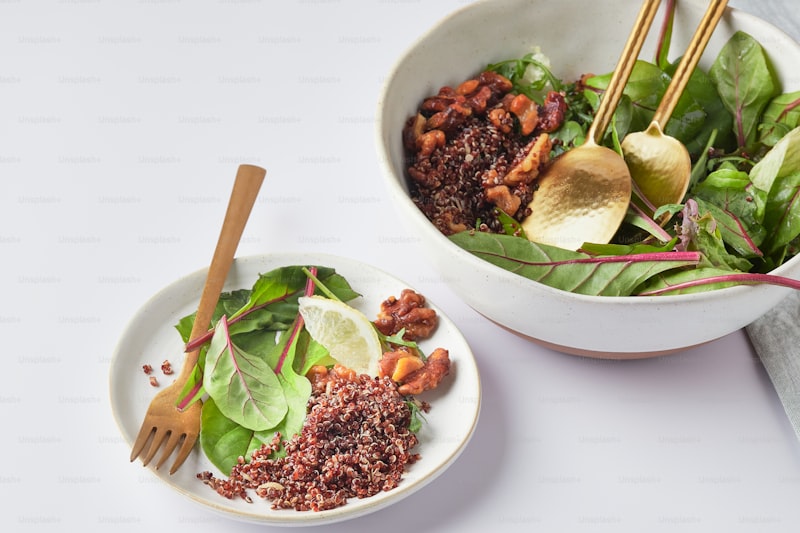As we’ve discussed in our Eat the Rainbow column, colour can make a difference on how you feel. From enhancing your appetite to providing you with a wider range of nutrients, green is one of those colours that should always be on your plate.
Chlorophylls are responsible for the green colour present in the veggies you eat. Eating green vegetables are one of the best ways to improve your health and keep you protected from diseases like obesity, diabetes, heart disease and cancer. A portion (about a cup) of greens will provide you with fibre, vitamins, minerals and plenty of antioxidants and can even keep you hydrated. More than 70% of the adult population in the UK don’t eat the recommended portion of veggies a day. How many veg have you had today?
The Benefits of Eating Green
According to a study done by the Health Survey for England, the risk of death by any cause is reduced by…
- 14% if you eat 1 to 3 portions of fruits and vegetables
- 29% for 3 to 5 portions
- 36% for 5 to 7 portions
- 42% for 7 or more
They also found that vegetables have higher health benefits than fruit. The density of nutrients that are available in green veggies is very high. Dark leafy vegetables are rich in iron, which helps carry oxygen through your body; vitamin A, to keep your eyes healthy; complex B vitamins, to keep your energy levels up; vitamin E to maintain healthy and radiant skin; and vitamin K, to keep your coagulation healthy. Greens are also packed with antioxidants. Research indicates that these antioxidants can help prevention various forms of cancer and other chronic diseases.
To assure that you obtain a wider range of nutrients it’s important to diversify the types of veggies you eat. Include these leafy greens in your meals to boost your health:
- Collards can add texture and innovation to your dishes. Convert them into wraps by taking a leaf of collard and placing in the centre your favourite filling which could be a stir or stew.
- Kale is a rich in vitamin A, C, K, B9 as well as calcium and potassium make in it an ideal vegetable to boost your nutrition.
- Rich in vitamins A and C, Swiss chard can be perfect to sautéing thanks to its soft texture
- Turnip greens count as 2 if you keep the tops on. They are full of vitamin A, C, K and calcium.
- Cooked spinach reduces the oxalates making calcium more readily available. Add it to your sandwiches, scrambled eggs, pasta, soups and casseroles to obtain vitamin A, B9 and C.
- Try mustard greens in combination with onion and heat just until wilted. Add lemon juice before serving to create the perfect balance of flavors.
- According to research, cabbage is rich in cancer-fighting compounds. Eat raw for and extra source of vitamin C or cooked in soups for extra fibre.
Where To Get Your Greens
The best way to eat your greens is from fresh sources. Canned, dehydrated and frozen veggies present an alternative that can be helpful to increase your intake. However, trying to obtain your greens from a capsule will not provide you with all the benefits that you can find in real fruits and vegetables.
Fruits and vegetables were designed by nature to satisfy the nutritional requirement of our bodies. Every compound in a fruit and veg has a special function. Fibre will allow fructose to be absorbed gradually to avoid glucose spikes. There are other factors that can influence how many nutrients you absorb from the food you eat. For instance, how you cook your food, the combinations you make, and even your stress level can influence the uptake of nutrients from the food to your body, better known as bioavailability.
Nutrients in actual fruits and veg are more likely to be readily available and provide you with more health benefits than a capsule. So, instead of wanting to eat your nutrients in a capsule go for the real stuff and increase your intake of greens.
See Also: Eat Like a Yogi: Top Tips to Fuel Your Body Before Class
Watch Out For Fake Greens
A little heat can actually be helpful to increase the absorption of some nutrients such as precursor of vitamin A and it can also deactivate some enzymes that lead to oxidation. However, intensive cooking can drain your veggies from their natural green and cause them to lose many of their vitamins, hence the dirty brown colour of veggies when you’ve overcooked them.
A typical example of when this happens is canned vegetables. To preserve foods for longer periods of time, canned foods have to go through high temperatures. Among the advantages of this is that the heat helps eliminate bacteria and might make some nutrients more readily available. For instance capacity to absorb vitamin a can be higher from canned carrots than raw ones. On the negative side, vitamins which are more prone to heat, like vitamin C, will be destroyed.
The way that the food industry remediates this is by adding artificial colours. In the canning of peas some of their chlorophyll is lost and usually replaced with an artificial colour. Sodium copper chlorophyllin or E141 is usually used and a permitted food additive in Europe. The main difference of this colorant is that the natural magnesium has been replaced with copper to increase its stability.
Breakfast, Lunch AND Dinner!
Sometimes we think of greens as exclusive of lunch or dinner. Make them part of your day to obtain optimal nutrition. The meal where veggies are most often forgotten about is breakfast. One way to begin the day is with a breakfast brucietta! Instead of spreading the usual sugary jam you can top your toast with cooked cavolo nero or black cabbage and top it with some cheese and olive oil. Prepare the cavolo nero by boiling with a pinch of salt. To increase flavour rub some garlic on your bread.
To add some protein and greens to the beginning of your day, have eggs with plenty of greens. Add a bit of oil to your pan to increase the absorption of vitamin A in the eggs and scramble a pair of eggs with spinach, green beans and broccoli. Sprinkle some spices, salt and pepper.
Every day is an opportunity to start over. Think about what and how you eat. Are there any improvements that you could make? Are you eating all the greens that your body needs? Simple changes in your diet, such as adding more colour, especially green can make an impact on whether you catch that flu all your co-workers seem to have or how you flow through your day. Make your days better by going green!
Did you miss the rest? Check out our entire













